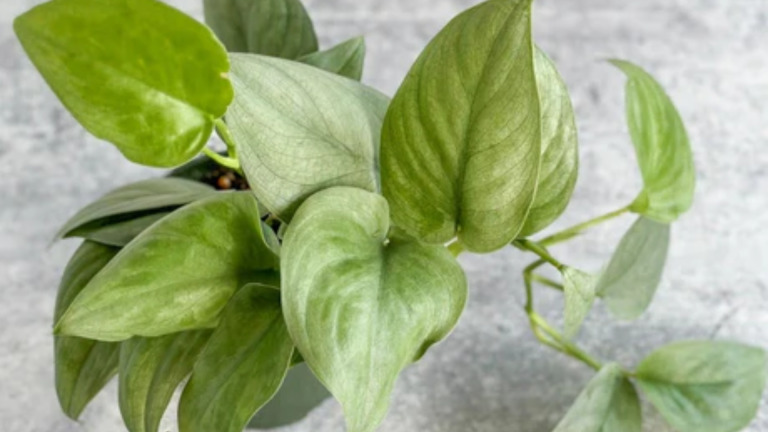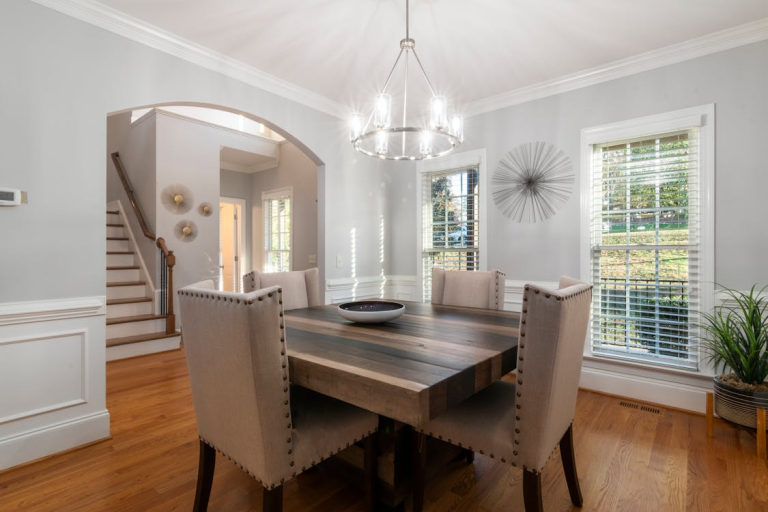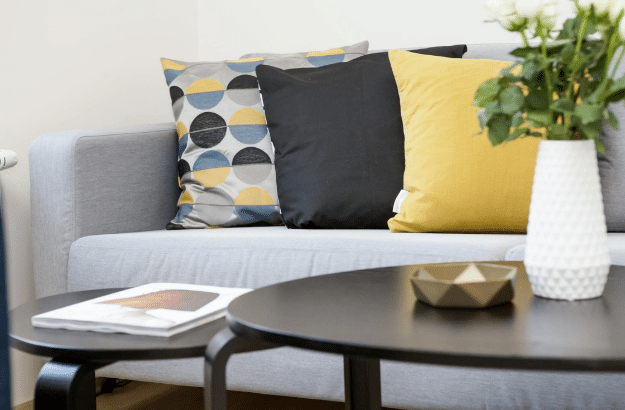Are you thinking about adding a beautiful trailing plant to your indoor garden? Scindapsus plants might be just what you’re looking for.
These outstanding vining plants are easy to care for, which makes them a great choice for both beginners and more experienced plant lovers.
With their eye-catching leaves and unique patterns, Scindapsus varieties have become very popular in homes everywhere. Some have silver spots, others show marbled colors, and each one brings something special to your space.
In this article, I’ll show you amazing types of Scindapsus and help you learn what makes each variety different. You’ll find out how to choose the right one for your space and how to keep it happy and growing strong.
I’ve grown many of these plants myself, so I’ll share helpful tips and ways to avoid the most common problems. If you want a plant for a shelf, a hanging basket, or a climbing setup, there’s a Scindapsus that’s perfect for you!
What Is Scindapsus?
Scindapsus is a group of tropical plants from the Araceae family, native to Southeast Asia in places like Thailand, Malaysia, and the Philippines.
They’re often confused with pothos because they look alike and need similar care, but they’re actually a different plant.
In the wild, Scindapsus plants climb trees, with leaves that start small and grow larger as they go higher.
Many types have striking silver patches on dark green leaves that give them a shimmery, almost metallic look. People sometimes call them “Satin Pothos” or “Silver Vine,” but they’re not true Pothos plants.
They’re popular houseplants because they’re low-maintenance, don’t need much water, and grow well in low to medium light. You can let them trail from shelves or grow them in hanging baskets.
What makes Scindapsus special is the unique pattern on each variety’s leaves. The mix of silver, cream, or white markings makes every plant feel like a one-of-a-kind piece of natural art.
Types of Scindapsus
Ready to explore the wonderful world of Scindapsus? Each variety has its own special beauty and characteristics.
Some have more silver splashes, others have unique variegation patterns, and a few have distinctive leaf shapes. Let’s look at popular types you might want to add to your collection!
1. Scindapsus Pictus ‘Argyraeus’

‘Argyraeus’ is a favorite starter plant for Scindapsus fans because it’s both easy to care for and beautiful to look at. Its small, heart-shaped leaves have soft silver dots scattered over deep green, giving it a delicate, painted look.
The silver covers about 20–30% of each leaf, which makes the green really stand out. This variety has a compact growth style, so it fits well in small pots, shelves, or hanging baskets. It’s known for being very hardy and forgiving, which is why many beginners choose it as their first Scindapsus.
2. Scindapsus Pictus ‘Exotica’

If you want something bolder, ‘Exotica’ is the perfect pick. It has larger leaves than ‘Argyraeus’ and much more silver, sometimes covering half the leaf.
The silver patterns create an extraordinary contrast against the dark green background, which shines in bright, indirect light. Its oval-shaped leaves look even more dramatic when allowed to climb.
This plant grows quickly and can get big, so it makes a strong statement. It’s more expensive but well worth it for its striking appearance.
3. Scindapsus Pictus ‘Silver Satin’

‘Silver Satin’ looks similar to ‘Argyraeus’ but has slightly bigger leaves with splashy silver instead of tiny dots. The markings give the plant a soft glow, which makes it great for brightening shelves or hanging planters.
Its leaves have a satin-like texture that really stands out, especially when the light hits them. This variety is known for being full and bushy when given enough space and light. It’s a great middle ground between subtle and bold if you want something eye-catching but not overwhelming.
4. Scindapsus Pictus ‘Silvery Ann’

‘Silvery Ann’ is one of the brightest Scindapsus varieties because its leaves can be almost completely silver. Some leaves have 70–80% silver coverage, giving them a frosted, glowing look.
New leaves may come in fully silver before turning more green as they age. The heart-shaped leaves are a bit more pointed than others, which gives them a delicate look.
This plant grows well in moderate light and makes a beautiful trailing plant. Under grow lights, its silver shines even more, making it a real showstopper.
5. Scindapsus Pictus ‘Jade Satin’

‘Jade Satin’ is completely different from the silver-speckled varieties—it focuses on rich, dark green beauty. The leaves are thick, smooth, and have a glossy, almost waxy finish that feels just a bit like velvet to the touch.
There’s little to no silver on this plant, which makes it stand out in a subtle, calming way. If you prefer bold green foliage with a tropical vibe, this one delivers.
It grows slowly but steadily and thrives in medium to bright, indirect light. It looks amazing in modern pots and brings a deep, lush feeling to any space it’s placed in.
6. Scindapsus Treubii ‘Moonlight’

‘Moonlight’ has long, narrow leaves with a soft silvery-green color that shines gently, giving the whole plant a smooth, metallic look. Instead of spots, each leaf has a uniform sheen that makes it feel modern and clean.
The leaves are thick and sturdy, almost like a succulent, which gives this variety a unique texture. New growth often starts out pale before deepening to its signature tone.
Although it grows slower than many Scindapsus types, the foliage makes it worth the wait. It fits beautifully into minimalist spaces and adds a subtle touch of style.
7. Scindapsus Treubii ‘Dark Form’

‘Dark Form’ shares the same leaf shape as ‘Moonlight’ but brings a bold twist with deep green leaves so dark they appear almost black. A soft silver sheen shows faintly in certain lighting, adding depth to its already rich look.
This plant has a dramatic feel and pairs beautifully with brighter varieties to create contrast. Though it’s slow to grow and still rare, it’s prized by collectors for its mysterious beauty. Its velvety leaves bring a stylish, moody tone that makes any plant shelf more striking.
8. Scindapsus ‘Silver Hero’

‘Silver Hero’ is a special kind of Scindapsus that mixes the shine of Treubii with the rounder leaves seen in other types. Its wide leaves are almost completely covered in a smooth, silver layer, while thin lines of dark green remain along the veins and edges.
This mix of silver and green makes the plant look bold and bright. Even though it doesn’t grow very fast, and it needs some extra humidity to look its best, it gives you amazing leaves that really stand out.
If you’re looking for a plant that looks neat and different, ‘Silver Hero’ brings a clean, shiny look that fits in almost any indoor space.
9. Scindapsus ‘Platinum’

‘Platinum’ has bright silver leaves that are so light, they almost look white. Only a small bit of green shows around the edges and through the center vein, which makes the silver pop even more.
Its smooth surface gives it a cool, icy shine that looks good near windows or under soft lights. This plant takes time to grow and prefers a room that’s not too dry, but once it settles in, it becomes one of the most noticeable plants in the room. It’s a great pick for anyone who enjoys clean, bright colors in their plant setup.
10. Scindapsus ‘Tricolor’

‘Tricolor’ is easy to spot because no two leaves look the same. The leaves have blotchy patches of dark green, light green, silver, and creamy white, all mixed together in fun and random ways.
This mix of colors makes each plant feel like a piece of art. It grows more slowly than other types and needs bright but gentle light to keep its colors from fading.
Too much direct sun can damage its soft leaves, so it’s best to place it near a window with filtered light. It’s a fun plant for someone who enjoys color and a little surprise in every new leaf.
11. Scindapsus ‘Black Satin’

‘Black Satin’ is one of the darkest types in the Scindapsus group. Its thick leaves are such a deep green that they look almost black, especially in soft light. A little silver shine shows up when the light hits the surface just right.
The leaves have a smooth, shiny finish that gives them a soft, polished look. This plant grows well in bright, indirect light and doesn’t need much to stay healthy.
It looks great when placed next to brighter plants, because the deep color really makes other leaves stand out. ‘Black Satin’ brings a calm, bold touch to any space.
How to Care for Scindapsus Plants?
Scindapsus plants are simple to care for, which is why they’re so popular. They grow best in bright, indirect light, but they can handle lower light if needed. If the leaves start to lose color or grow more slowly, they likely need more light.
These plants don’t like too much water. It’s best to let the top few inches of soil dry out before watering again. Overwatering can lead to yellow leaves, while underwatering may cause the leaves to curl.
They prefer soil that drains well, so a mix with potting soil, perlite, and bark is a good choice. Scindapsus like some humidity, but will grow just fine in regular indoor air.
Fertilizer helps during spring and summer, but only once a month. There’s no need to feed them in winter. You can prune the vines to shape the plant and grow new ones from cuttings. With just a little care, Scindapsus will thrive and look great in your home.
Conclusion
Scindapsus plants are a great addition to any plant lover’s collection because they’re easy to care for and have beautiful, silver-marked leaves that stand out in any room.
With so many types to choose from—like the popular ‘Argyraeus’ or the rare and eye-catching ‘Silver Hero’—there’s truly something for every taste and space.
This guide was written to help you discover different Scindapsus varieties, and hopefully it’s inspired you to try growing one or more of them yourself.
You can mix a few types together to create a lovely arrangement of vines with unique colors and patterns. Each variety has its own special look, which makes collecting them interesting and fun.
If you’re just starting out or you’ve been growing plants for years, Scindapsus is a great choice because it’s easy to grow and always looks good.
They’re strong, stylish, and perfect for adding a touch of green to your space. If you’ve grown any of these already, or plan to, I’d love to hear about it, so feel free to share your favorite in the comments!













